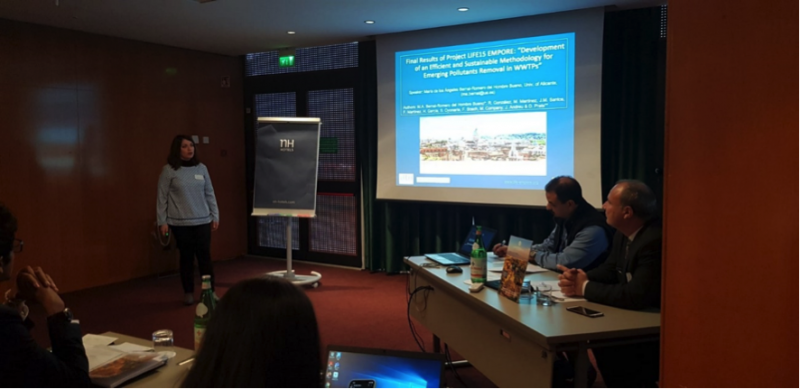News

24th December 2019, en News
Last 12th of December the ‘XIII International Research Conference on Wastewater Treatment and Treatment Plants’ took place in Rome.
LIFE EMPORE, represented by the University Institute of Water and Environments Sciences of the University of Alicante, was present at this convention as a collaborator and rapporteur from the hand of the researcher María de los Ángeles Bernal Romero del Hombre Bueno, who took part in the aforementioned event with the oral presentation ‘Final Results of Project LIFE15 EMPORE: Development of an Efficient and Sustainable Methodology for Emerging Pollutants Removal in Wastewater Treatment Plants’ (autors: M.A. Bernal-Romero del Hombre Bueno, R. González, M. Martínez, J.M. Santos, F. Martínez, H. García, S. Oyonarte, F. Bosch, M. Company, J. Andreu y D. Prats). The organization awarded the presentation as the best.
The presence of micro contaminants in the secondary effluent demonstrates the need to apply a tertiary treatment. The processes of the pre-treatment line, conventional filtration, and ultrafiltration (UF), the record of low reductions in the concentration of micro contaminants, but the conditioning of effluents for the subsequent treatment of reverse osmosis (RO), the elimination of turbidity and suspension in suspension (SS).
In the permeate treatment line, the OI obtained a high-quality effluent in which only traces were detected in specific samples of some compounds (eg glyphosate, carbamazepine, diclofenac, and sulfamethoxazole). The subsequent filtration of the permeate with activated carbon obtains free effluents from the micro contaminants studied.
In the line of treatment of rejections, UV treatment was not effective in the elimination of micro contaminants due to the high turbidity and presence of SS of UF and OI concentrates. On the contrary, electro oxidation does reduce the concentration of micro contaminants in these concentrates, obtaining a quality of the effluent with respect to the presence of these compounds similar even sometimes higher than that of the secondary effluent. Modification efficiencies were diverse, depending on the nature of the compounds, being significant for compounds such as glyphosate and isoproturon.
The proposed methodology allows the modification of micro contaminants present in WWTP effluents, reducing the environmental impact of the discharge of these effluents into the aquatic environment.
Are you an Associated Beneficiary? Access private area to download documents Private zone